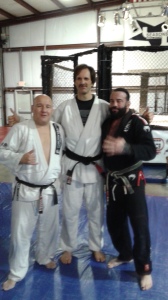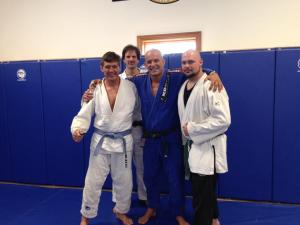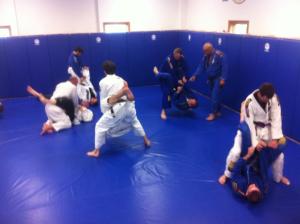After my review of Rob Biernacki’s online academy a few weeks ago I was contacted by Nic Gregoriades, who offered me access to his new online academy in exchange for a review.
For those who don’t know Nic, he’s the first guy promoted to black belt by Roger Gracie and author of Jiu-Jitsu:The Black Belt Blueprint and Jiu Jitsu: Beyond the Black Belt. His academy website is http://www.jiujitsumasterclassacademy.com/. Monthly rates are $25/month, with discounts available for yearly or lifetime memberships.
The academy is only a few months old, so there isn’t a ton of material available yet, but there’s some good quality instruction already, with more being added every week. The video is divided up into the following categories:
- Weekly classes – focusing on Nic’s latest discoveries and material he’s working on.
- Monthly seminars – focusing on specific positions or concepts
- Meet the Masters – interviews and technique sessions with other instructors
- Rolling analysis – narrated sparring videos with detailed breakdowns
- Podcasts – I haven’t listened to any of these yet, but they may be of interest to podcast fans.
Over all, I’d estimate he’s adding about 3 hours or so of good quality video per month so far.
The heart of the site is probably the weekly classes. These are actual group classes recorded at a regular academy, although the content is selected for the online students. Normally I’m not a fan of this approach, but in this case the camera angles are perfect, the audio quality is excellent, and Nic manages to give you the impression that you are just another student physically present in a small group class.
The official description reads “Nic’s current classes featuring his latest jiu jitsu discoveries and what he’s working on at the moment.” That seems to be accurate. I’m hearing a lot of “so-and-so showed me this move last year and I’ve had a lot of success tapping people out with it over the last few months, so here’s how it works.” The material isn’t tremendously esoteric, but I’m picking up a lot of nice details as well as some actual techniques I’ve never tried.
Nic’s instruction isn’t as relentlessly conceptual as that of Ryan Hall or Rob Biernacki. He doesn’t flood you with every conceivable detail (as Rener & Ryron do in their online Gracie University). What he does do is probably about optimal for a regular classroom demonstration. He notes the key technical details and some important concepts for making the move work, but not enough to overwhelm those with more limited attention spans. As an instructor, I enjoyed watching his pedagogic style.
(It does occur to me that Nic might be missing out on a potential advantage of the classroom format by not showing more of the hands-on troubleshooting, corrections, and question answering he does for students in the class as they try what he has demonstrated. I think I’ve come across only one example where he does this so far. In my experience as a teacher those moments which help one student often help the rest of the class.)
The seminars, meet the masters, and rolling analysis sections are likewise well shot, with good audio, and clear instruction. He explains enough technical details and concepts to be effective, but keeps things reasonably concise.
If you’re looking for a specific topic, the organization of the site is not ideal. Videos are laid out by date in each section, i.e. Classes/April 2018/Week 2. Fortunately, there is an excellent search function and the videos are tagged by category, position, and concepts covered. For example, a video on details for the double bow & arrow choke is tagged under submissions, handfighting, back control, power of perpendicular angle, strong/weak shape, and hip vectoring.
Overall, Nic’s Master Academy is a good source for BJJ students who want some good quality supplemental instruction on a variety of topics from an excellent instructor. Right now the available topics are a bit random, but as he adds more material I imagine it will reach a point where you can just search and find specific material you might be interested in.



